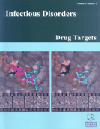- Home
- A-Z Publications
- Infectious Disorders - Drug Targets (Formerly Current Drug Targets - Infectious Disorders)
- Previous Issues
- Volume 12, Issue 5, 2012
Infectious Disorders - Drug Targets (Formerly Current Drug Targets - Infectious Disorders) - Volume 12, Issue 5, 2012
Volume 12, Issue 5, 2012
-
-
Antimicrobials Targeted to the Replication-Specific DNA Polymerases of Gram-Positive Bacteria: Target Potential of dnaE
More LessAuthors: Marjorie H. Barnes, Michelle M. Butler, George E. Wright and Neal C. BrownDNA polymerases pol IIIC and dnaE [i.e. pol IIIE] are essential for replicative DNA synthesis in low G:C Gram-positive eubacteria. Therefore, they have strong potential as targets for development of Gram-positive-selective antibacterial agents. This work has sought to extend to dnaE the recent discovery of antimicrobial agents based on pol IIICspecific dGTP analogs. Compound 324C, a member of the same dGTP analog family, Read More
-
-
-
Chromium-Picolinate Therapy in Diabetes Care: Individual Outcomes Require New Guidelines and Navigation by Predictive Diagnostics
More LessAuthors: Kristina Yeghiazaryan, Hans H. Schild and Olga GolubnitschajaAims: Nephropathy is the leading secondary complication of metabolic syndrome. Nutritional supplement by chromium-picolinate is assumed to have renoprotective effects. However, potential toxic effects reported increase the concerns about the safety of chromium-picolinate. The experimental design aimed at determining, whether the treatment with clinically relevant doses of chromium-picolinate can harm indivi Read More
-
-
-
Is Helicobacter pylori the Infectious Target to Prevent Gastric Cancer? An Interdisciplinary Point of View
More LessGastric carcinogenesis, which may well extend over decades, is characterized by a slow stepwise evolution from superficial gastritis to glandular atrophy, intestinal metaplasia, dysplasia, and finally, adenocarcinoma. This sequence provides an excellent opportunity for the prevention or early detection of the events preceding development of the neoplasm. In 1994, the International Agency for Research on Cancer defined Heli Read More
-
-
-
Adherence to Anti-Retroviral Therapy and Its Determinants in HIV/AIDS Patients: A Review
More LessAuthors: Sahra Emamzadeh-Fard, Sahar E. Fard, SeyedAhmad SeyedAlinaghi and Koosha PaydaryAlthough Highly Active Anti-Retroviral Therapy (HAART) significantly reduced HIV/AIDS mortality, appropriate adherence level is recommended for viral suppression and therapeutic response in People Living with HIV/AIDS (PLWHA). In the most studies, adherence is defined as taking ≥95% of prescribed medications. Poor or non-adherence may lead to treatment failure and drug resistance. There is no golden standard for eval Read More
-
-
-
Shooting At the DARC: Potential Issues with Species-Specific Antimalarials
More LessAuthors: I. Woolley and K. HorneScientific drug design enables the production of novel agents that may be specific for individual malaria species, particularly by targeting their methods of cellular entry. Though there are practical and theoretical barriers to introducing novel agents into clinical practice, there may also be theoretical benefits to encourage further investigation of such agents, including a reduction in the rate of development of falciparum re Read More
-
-
-
Biology of Circulating Nucleic Acids and Possible Roles in Diagnosis and Treatment in Diabetes and Cancer
More LessThe presence of DNA and RNA circulating in human plasma and serum is described. The possible sources of the DNA/RNA in blood, their ability to enter other cells and to express in the recipient cells are discussed and the relationship with metastases considered. The possible role(s) of the DNA/RNA in clinical diagnosis, in monitoring treatment and in prognosis are considered for diabetes and oncology.
-
-
-
Malaria, Anti Malarial Drugs and the Role of Melatonin
More LessMalaria, one of the most deadly diseases of our time affects more than 200 million people across the globe and is responsible for about one million deaths annually. Until recently Plasmodium falciparum has been the main cause for malarial infection in human beings but now Plasmodium knowlesi from Malaysia remains as one of the most virulent parasite spreading fast not only in Malaysia but in different parts of the worl Read More
-
-
-
Lessons from Anaplasma phagocytophilum: Chromatin Remodeling by Bacterial Effectors
More LessAuthors: Kristen E. Rennoll-Bankert and J. Stephen DumlerBacterial pathogens can alter global host gene expression via histone modifications and chromatin remodeling in order to subvert host responses, including those involved with innate immunity, allowing for bacterial survival. Shigella flexneri, Listeria monocytogenes, Chlamydia trachomatis, and Anaplasma phagocytophilum express effector proteins that modify host histones and chromatin structure. A. phagocytophilum modulat Read More
-
-
-
Nutritional Antioxidants and Their Applications in Cardiometabolic Diseases
More LessBy Mena SooryThere is an increasing global trend in cardiometabolic disorders being a leading cause of morbidity and mortality. Adverse dietary habits and sedentary lifestyles contribute to cardiovascular disease (CVD) and diabetes mellitus (DM). Dietary nutrients in nuts have attracted attention in recent literature due to their beneficial effects on CVD by attenuating lipid profiles, inflammation and oxidative stress. There is well-esta Read More
-
Volumes & issues
-
Volume 25 (2025)
-
Volume 24 (2024)
-
Volume 23 (2023)
-
Volume 22 (2022)
-
Volume 21 (2021)
-
Volume 20 (2020)
-
Volume 19 (2019)
-
Volume 18 (2018)
-
Volume 17 (2017)
-
Volume 16 (2016)
-
Volume 15 (2015)
-
Volume 14 (2014)
-
Volume 13 (2013)
-
Volume 12 (2012)
-
Volume 11 (2011)
-
Volume 10 (2010)
-
Volume 9 (2009)
-
Volume 8 (2008)
-
Volume 7 (2007)
-
Volume 6 (2006)
Most Read This Month
Article
content/journals/iddt
Journal
10
5
false
en


